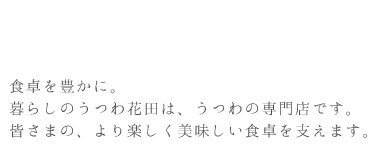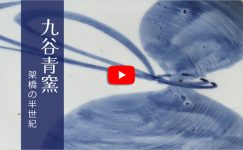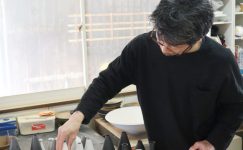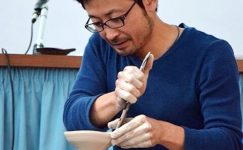English version of the interview here.
“What I Can Bring the Most Joy to Others” – Katsutoshi Mizuno
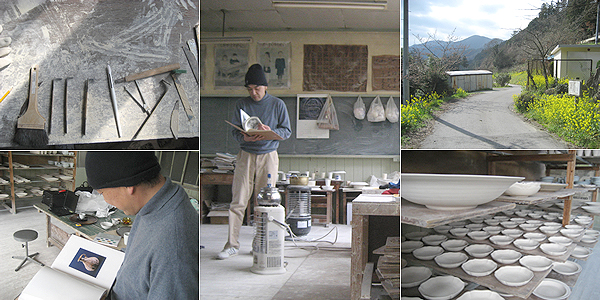
Katsutoshi Mizuno captivates many fans with his refined white porcelain.
His work, pursuing the ideal “form,” is a delicate balance between his vision and the technical skill to achieve it.
For the May special exhibition, he pursued his style even more than usual.
Hanada: Could you tell us how you came to aspire to make pottery?
Mizuno: My family ran a sake brewery.
Old vessels, hanging scrolls, and the like were displayed in the tokonoma, and even as a child, I would have trays prepared for banquets.
Being surrounded by these things, I naturally became interested in vessels. It was very enjoyable.
Hanada: So you grew up surrounded by banquets and vessels (laughs). And then you began making pottery?
Mizuno: Yes, I grew fond of the vessels I was familiar with.
Not just the objects themselves, but the people around them, the sake brewers,
the food, the atmosphere of the house—everything together.
For me, the vessels were at the center of it all.
Hanada: And then you joined Kutani Seiyō Kiln.
Mizuno: After graduating school, I attended a pottery school in Seto, worked at Kutani Seiyō Kiln, and then went to Tobe.
I was at Kutani Seiyō Kiln for about six or seven years.
Hanada: I heard you chose Tobe because of the clay.
Mizuno: I considered working in Kure, where my roots are,
but I confirmed that Tobe had the clay suitable for making the vessels I aimed for.
Although Tobe is known for thick pottery, the clay can also be thrown thin.
The glaze melts in the kiln, so I adjusted it carefully to get the current color.
I wanted to achieve a smooth, rich feel. When I asked a local clay supplier if there was a place in Tobe,he introduced me to Hirotamura village, which is where my workshop is now.
Hanada: Had you been to Tobe before?
Mizuno: I had passed through, but I didn’t know it well.
I only had the impression that Tobe made thick pottery.
Hanada: And then, in Tobe, you settled on the style of white porcelain.
Mizuno: After leaving Kutani Seiyō Kiln, I spent some time experimenting.
I kept thinking: What is it I truly want to do? What suits me best?
What had I admired since I started making pottery?
I tried many things over two or three years.
Then I realized that the medium through which I could bring the most joy to people was white porcelain.
Hanada: White porcelain fits you best, then.
Mizuno: I love “form.” I don’t know why, but I’ve always loved form (laughs).
Since my student days, I went around Tokyo looking at all sorts of shapes.
Especially the forms of vessels from the Korean Joseon dynasty or Northern Song dynasty.
In this context, I came to think that white porcelain was the most suitable medium to express the forms I loved.
By looking at old pieces, you can clearly see what you lack—not only in technique but also in sensitivity.
Making vessels is not just about skill; it’s about enhancing your technique to achieve the desired form.
Hanada: In white porcelain, “form” is extremely important, you think.
Mizuno: Of course. There’s no painting, and it’s not really about enjoying surface “taste.”
It’s not only about the form itself, but where you base it matters.
Hanada: It’s about learning from tradition. As you look at and handle old pieces, various insights gradually accumulate within you.
Mizuno: In terms of accumulation, food is similar for me.
If you eat well-prepared food regularly, you can tell when something tastes off.
It’s the same with vessels. It’s not about logic.
Something is delicious because it is delicious. Conversely, it’s bad because it is bad.
Later, you may need reasoning to explain it, but first, it’s important to judge intuitively.
Hanada: Too much reasoning would make work less enjoyable, right?
Mizuno: Exactly. I’m especially moved by simple, undecorated plates. They’re amazing.
A simple, ordinary vessel that captures people’s hearts must have a very strong core.
If the essence is lacking, people tend to decorate excessively to compensate.
Hanada: That pewter plate was also very popular. It’s simple too.
Mizuno: That’s the challenge. Once you get used to it, it actually becomes harder.By seeing the essence of form, the level you aim for rises.
Hanada: That’s a welcome challenge.
Mizuno: Every piece of pottery is a test.
Once it comes out of the kiln, it either works or it doesn’t.
You can’t dwell on past failures, and just because something succeeded before doesn’t guarantee the next attempt will.
Every time, it’s about whether it can bring joy to people.
Although many pieces are made continuously, each one is sent as a finished product.
Each piece must provide enjoyment. That’s all.
There may be a “next,” but in the moment, there really isn’t a “next” (laughs).
Hanada: Regarding the three pieces for the May exhibition—the Mocco plate is beautiful, and the rice bowls are nice too.
What does “making vessels for yourself” mean to you?
Mizuno: Making for myself is basically the same as my usual work.
I always make what I want to make. I continue to create what I admire.
Making for myself is just the usual. If anything, it’s something more faithful to my style.
Hanada: It’s even more in the Mizuno style.
Mizuno: Above all, it’s what I want to make, what I think is good.
Hanada: You’ve made refined, elegant vessels that are truly Mizuno.
Mizuno: Thank you.
But when I only work with white porcelain, sometimes I feel drawn to red painting or blue-and-white pieces. They’re cute (laughs).
≪END≫

「自分が人を一番楽しませられるもの」 水野克俊
端正な白磁で多くのファンを魅了する水野克俊さん。
「かたち」を追い続ける水野さんの仕事は理想のかたちとその実現のための技術のせめぎあい。
5月企画展に向けては、いつも以上に自分のスタイルを追求してくれました。
花田:うつわづくりを志すようになったいきさつを教えて下さい。
水野:実家が造酒屋だったでしょう。
古いうつわ、掛け軸などが床の間に置いてあったり、
宴会などがあると子供の私にもお膳が用意されていたりと、
そうやってものに囲まれている内に、うつわに興味を持つようになった。とても楽しかった。
花田:宴会とうつわに囲まれて育った幼少青年期(笑)。で、やきものを作り始めるわけですね。
水野:そう、身近にあった「うつわ」というものが好きになりました。
そのものだけじゃなくて、それを囲む人々、酒を造る人、
料理、家全体の雰囲気などなど全部ひっくるめて。
僕にとっては、その中心にうつわがあったんだと思います。
花田:それで九谷青窯入社です。
水野:学校卒業した後、瀬戸の窯業学校入って、九谷青窯で世話になって、それで砥部のほうに行きました。
6-7年かな、青窯にいたの。
花田:砥部を選んだのは土が理由だと聞きました。
水野:自分のルーツである呉でやろうかとも考えたんですが、
目指すうつわを作ることができる土が砥部にちゃんとあることを確認できたんです。
砥部っていうと、分厚いイメージあるけど、土は薄くも挽ける。
釉薬は窯で溶かし過ぎると青白磁になっちゃうので、色々調節しながら今の色を出しました。
とろっとした雰囲気を出すためにね。で、そこの粘土屋さんに、どこか砥部あたりで場所ないですかって聞いたら、
今の仕事場である広田村を紹介してもらったんです。
花田:砥部には来たことあったのですか?
水野:通りがかったことはあったけど、よくは知らなかった。
砥部って分厚いもの作るんだろうなってイメージくらいしかなかった。
花田:そして、砥部で白磁というスタイルに行きつきます。
水野:九谷青窯をやめたあと、しばらく試行錯誤していました。
自分のやりたいものってなんだろう、一番自分に合っているものはなんだろう、
やきものを始めてから憧れていたものって何だろう、
って考え続け、色々試して、二、三年くらいかな。
で、自分が人を一番楽しませられるのは白磁だな、と。
花田: 白磁が一番しっくりくるのですね。
水野: 「かたち」が好きなんです。なんだか知らないけど、昔からかたちが好き(笑)。
学生の頃から東京出てきちゃ色々なかたちを見て回っていました。
特に、李朝や北宋の頃のもの。
そんな中で、白磁は自分の好きなかたちを表現するのに最もふさわしいと考えるようになりました。
古いものを見ていると、なにが自分に足りないか、よく見えてきますよ。
技術だけでなく感覚もね。
うつわ作りって、自分の技術ありきではなく、
目標とするものに合わせて技術を高めていくもんなんだな、そう思いました。
花田:焼き物の中でも、白磁にとって「かたち」は非常に重要な部分です。
水野:そりゃあ、絵付けもないし、そんなに「あじ」を楽しむ類のものでもない。
かたちだけの話じゃないけど、ベースをどこにするかって部分が大事。
花田: 伝統に学ぶ、と。古いものを見たり使ったりしているうちに、
自分の中に色々なものが蓄積されていきます。
水野:蓄積という意味では、僕にとってある意味、食べものも一緒です。
普段ちゃんと料理されたものを食べていたら、感覚で不味いものはわかるじゃない。
うつわも一緒。これは理屈じゃないんだけどね。
美味しいです、だって美味しいから。逆に、まずいです、だってまずいんだもんって。
そのあと、説明のための理屈が必要になることはあるかもしれないけどね。
「だって変だから・・・」って理屈の前に感覚的に判断することが大切。
花田:理屈ばかりだと、仕事していて楽しくないでしょうし。
水野:そうですね。特に僕は装飾のないシンプルな皿ほど心打たれる。すごいなって。
何でもないようなシンプルなうつわが人の心を掴むっていうのは、よほど芯がしっかりしているんだなと思います。
そうやって本質があればいいんだけど、ない場合はいろいろ装飾して誤魔化そうとしてしまう。
花田:あのピューター皿もヒットでした。あれもシンプルです。
水野:それが大変で、なんか慣れてきたら却って難しくなってきちゃった。
かたちの本質が見えたことによって目指すレベルも上がってしまった。
花田:歓迎すべきことです。
水野:やきものって一回一回が勝負なんです。
一回窯出ししてうまくいくか、いかないかで決まってしまう。
以前に失敗したことを引きずれもしないし、逆に上手くいったからと言ってそれが続くとも限らない。
その時その時で人を楽しませることができるかどうか。
継続して作るものも多いけど、原則一回一回、完成品として送るわけですから。
その度にそれらが人に楽しみを与えてくれなきゃ困るわけで。それだけです。
次はあるようで・・・でもやっぱりその時点その時点での「次」というものは無いんだ(笑)。
花田:さて、5月企画展の3つ。あのモッコ皿もきれいだし、飯碗もいいですね。
水野さんにとって「自分のために作るうつわ」とは?
水野:じぶんのためってのは、結局いつもの仕事と一緒です。
いつも「作りたいもの」を作っているから。自分が憧れているものに対して制作を続けているわけです。
私のためっていうのは、いつも通り。強いて言えば、より自分のスタイルに忠実なもの、かな。
花田:より一層水野スタイルです。
水野:とにかく、自分が作りたい、いいなあ、って思うものです。
花田:きれいで端正な水野さんらしいうつわができましたね。
水野:ありがとう。 でも白磁ばっかりやっているとね、たまにいいなって思います、赤絵とか染付とか。かわいいなあ、って(笑)。





